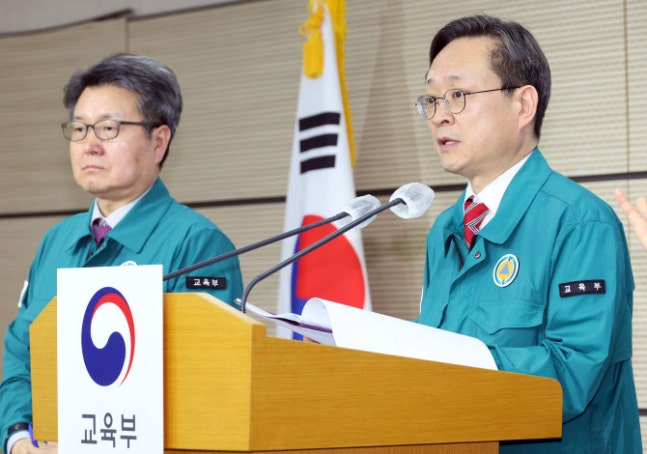Interview with Shim Min-cheol, Deputy Director of Human Resources Policy at the Ministry of Education
“Mitigating regional extinction by attracting population through regional medical schools”
Challenge to implement the goal of ‘canceling the increase in medical school enrollment’ in medical field
“Increased number of reports on coercion of medical students to return… indicates increase in willingness to return”, ‘[E-Daily Reporter Shin Ha-young] “I believe it will have an effect in alleviating the crisis of regional extinction.”‘,
,
,
|
, ‘Shim Min-cheol, Deputy Director of Human Resources Policy at the Ministry of Education, responded to the observation that the demand for ‘local study abroad’ is increasing due to the expansion of the regional medical talent selection system. He expressed concerns that the system designed to prevent the migration of local students to metropolitan areas could instead become a pathway for metropolitan students to enter medical schools, potentially diluting the purpose of the system.’,
,
, ‘According to the Ministry of Education on the 1st, the total number of medical school admissions publicly announced by 39 universities for the 2025 academic year increased by 1497 to 4610 from the previous year (3113). This year’s decision to increase medical school enrollment, the first in 27 years, was aimed at strengthening regional healthcare services. The fact that 71.2% (3284) of the total recruitment quota for medical schools (4610) is allocated to non-capital regions supports this initiative. Furthermore, the Ministry increased the number of students admitted through the regional medical talent selection system from the previous 1025 to 1913, an increase of 888.’,
,
, ‘Compared to the general admission process, the regional medical talent selection system has lower competition rates and passing scores. With the enlargement of the selection scale by 87% since the previous year, parents of students are increasingly considering relocation to rural areas to send their children to medical schools.’,
,
, ‘The regional medical talent selection system, implemented from the 2016 admissions process after its introduction in 2014 to alleviate the departure of local students to metropolitan areas, was initially a recommendation. However, starting from the 2023 academic year, a mandatory “40% recruitment” (20% for Gangwon and Jeju) was enforced.’,
,
, ‘The argument that the introduction of the system could dilute its purpose if there is an increased demand for study abroad in rural areas is being raised in this context. If students from metropolitan areas come to rural areas and use medical schools as a pathway to enter, contrary to the original intention of the system designed for local students, it could be seen as contradictory.’,
,
, ‘In response to this, Deputy Director Shim stated, “The basis of the regional medical talent selection system is the Law for the Promotion of Local Universities (Law on the Promotion of Local Universities and Regional Talent Cultivation), which aims to enhance the competitiveness of local universities and contribute to balanced development among regions.” He added, “Expanding the admission of regional medical talents to local medical schools can help alleviate the migration of local students to metropolitan areas and increase the influx of population from metropolitan areas to rural areas, which could also aid in mitigating regional extinction.”‘,
,
, ‘Deputy Director Shim emphasized that what happens after students are admitted to medical schools through the regional talent selection system is more crucial. Increasing the number of doctors who graduate from rural medical schools and settle in rural areas is essential to strengthen the local healthcare infrastructure. He stated, “According to the 2022 research report from the Medical Policy Research Institute of the Korean Medical Association, the probability of working in non-capital regions is 2.12 times higher for medical school graduates who graduated from rural areas.” He further emphasized the importance of creating settlement conditions for these graduates to encourage them to practice in rural areas.’,
,
, “After the official implementation plan for the 2025 academic year was finalized by the National Association of Universities, it has become difficult to retract the ‘medical school enrollment increase’ advocated by the medical field. Following the dismissal ruling by the Seoul High Court, the admission schedule has already resumed, and the recruitment guidelines have been announced. Deputy Director Shim stated, “It is no longer just a matter for the medical field and medical schools, but a national issue involving high schools, universities, students, parents, and others.” He added, “Even if a stay of execution is requested from the Supreme Court, it is practically difficult to achieve the effect of ‘canceling the increase in medical school enrollment.'”,
,
, ‘For these reasons, Deputy Director Shim hopes for the return of medical students to their classes. He said, “While there was only one reported case of collective action coercion at one metropolitan medical school last month, the number of reported cases has increased to three recently.” He explained, “The increase in reports indicates an increase in students’ willingness to return to classes.”‘,
,
, ‘Deputy Director Shim stated, “Although it may be inevitable for students to refuse to attend classes until the end, the Ministry of Education will persuade as many students as possible to return to classes” and “Dialogue with medical students is always open.”‘,
,
,


